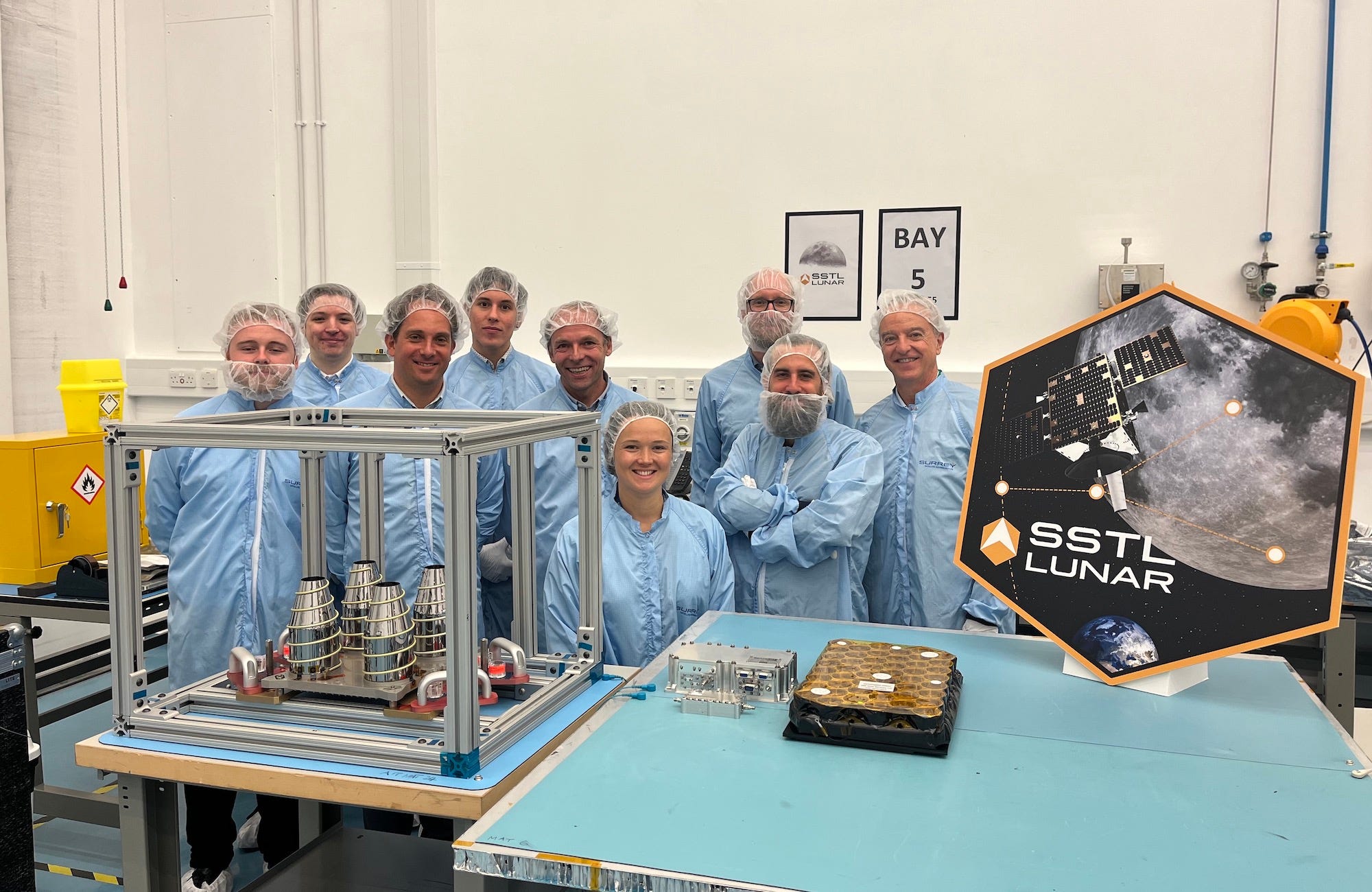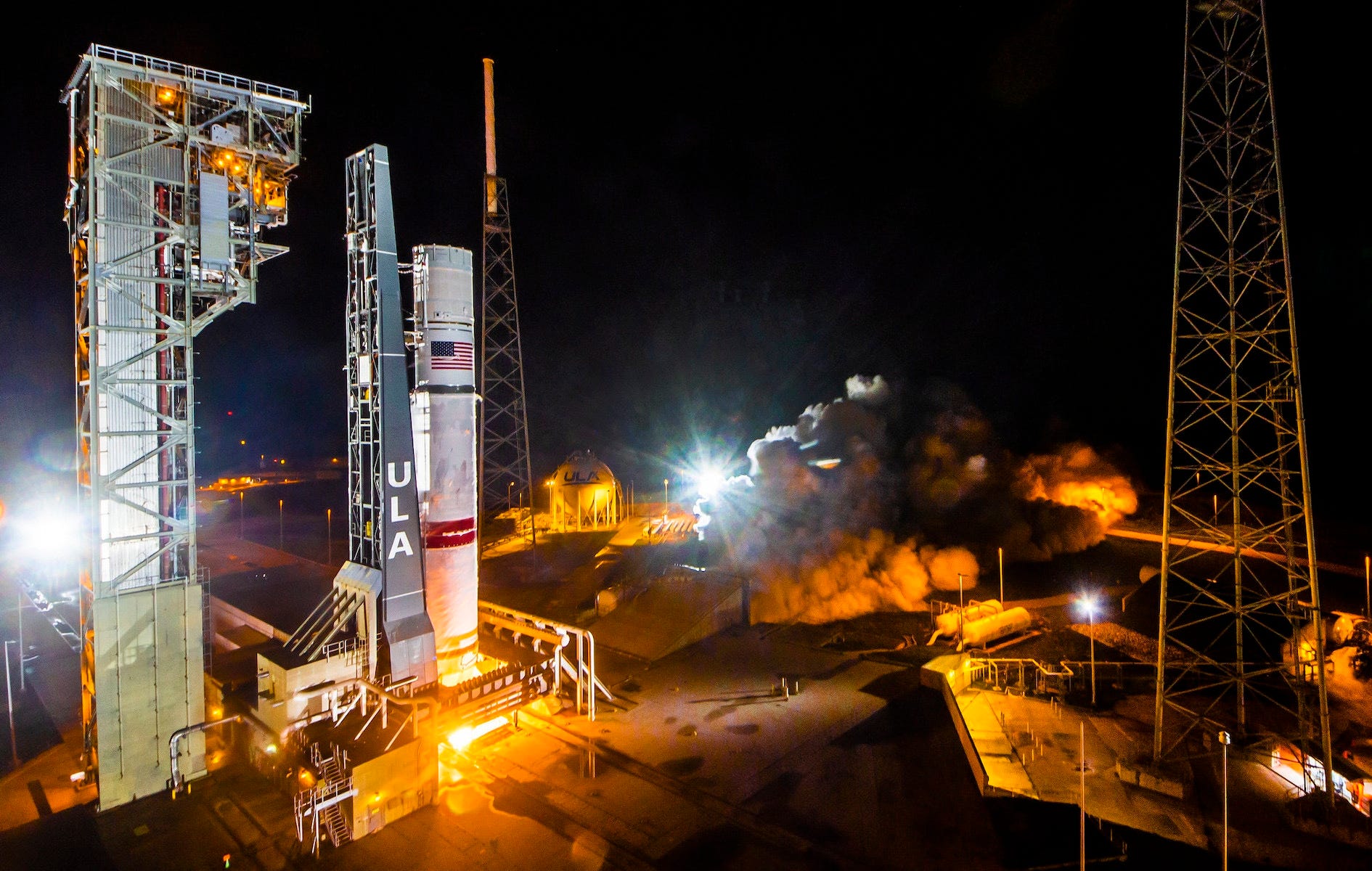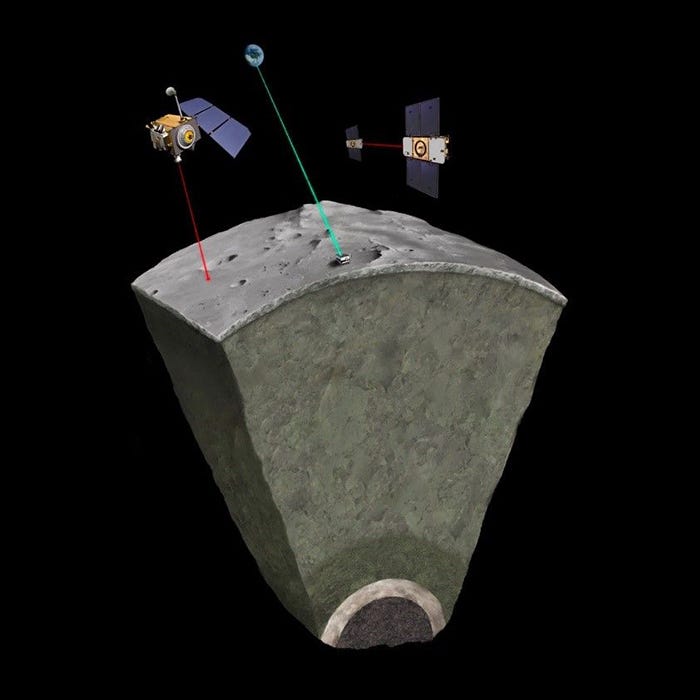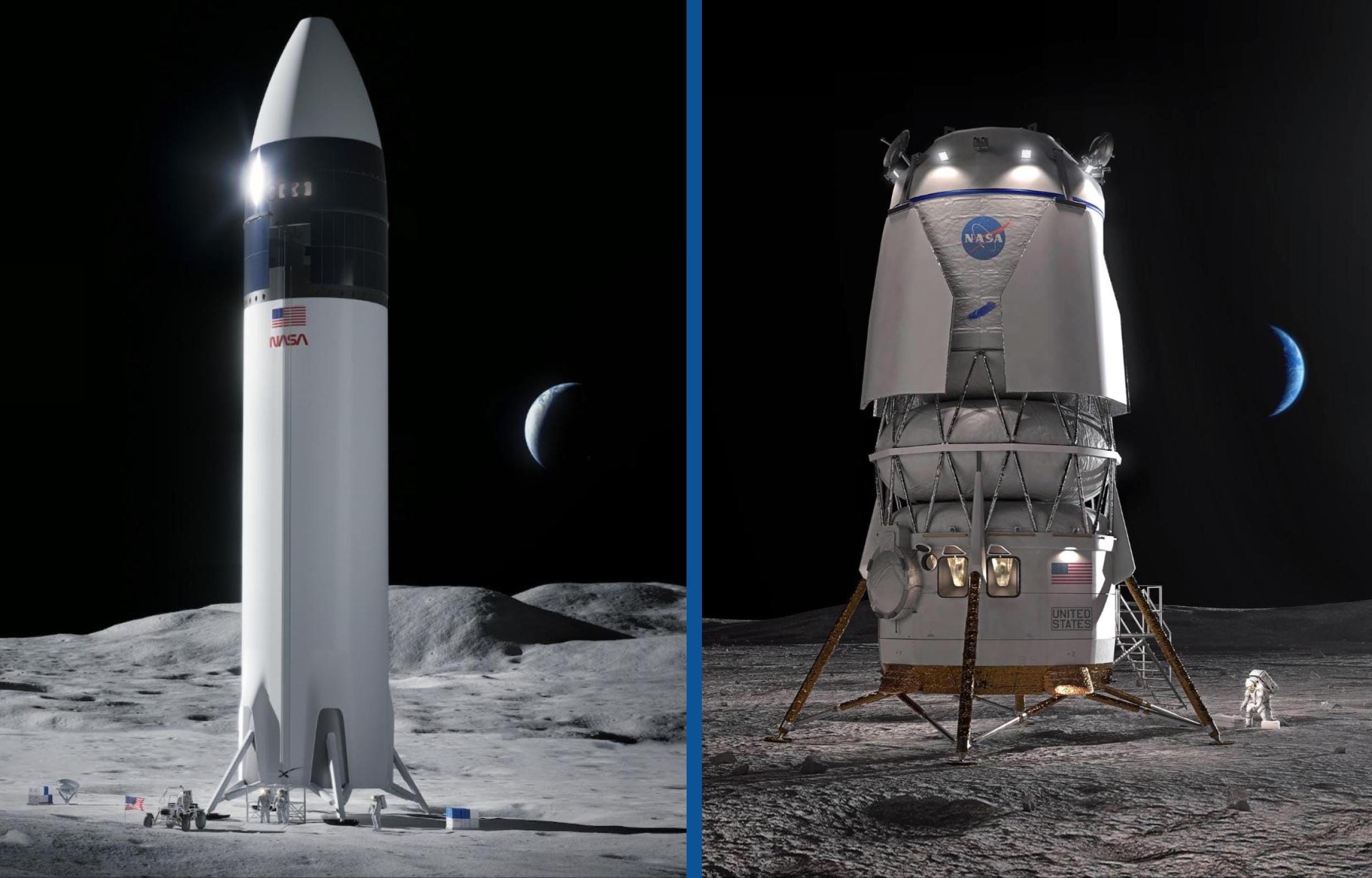Moon Monday #131: Pathfinding for lunarbound hardware, gleaning a solid core, and more
Hardware for Moonbound navigation arrives

SpacePNT has delivered the ‘NaviMoon’ GNSS receiver for SSTL’s ESA-backed Lunar Pathfinder orbiter, which is targeting a 2026 launch. The payload is at the heart of an ESA-NASA collaboration to demonstrate a location fix at Luna using signals millions of times fainter than those used by our phones. When in lunar orbit, Pathfinder will regularly orient NaviMoon towards Earth to get positioning fixes from Earthbound GNSS satellites, which mission engineers will compare with conventional radio ranging methods to see how accurate the new technique is. Moreover, a NASA-provided retroreflector, which was delivered in November 2022 for spacecraft integration, will also help engineers independently validate the GNSS fixes.
No spacecraft has used all the above three ranging services simultaneously from the Moon. If Pathfinder’s demonstration is wholly successful, it will pave the way forward for a wave of future Mooncraft to navigate at Luna without direct reliance on terrestrial ground stations. For ESA, a successful test would boost their upcoming commercial navigation service called Moonlight. NASA itself aims to test a similar GPS fix but from the Moon’s surface on Firefly’s 2024 mission part of the agency’s CLPS program.
How will Lunar Pathfinder get to the Moon? As part of an agreement, NASA is aiming to deliver the 280-kilogram spacecraft to lunar orbit in 2026 via a commercial Firefly CLPS lander. In return, ESA will let NASA use the polar-orbiting Pathfinder to relay communications between the agency’s surface hardware and Earth.
More mission updates
- Along the sidelines of the International Conference on Spacecraft Mission Operations, ISRO Chief S. Somanath said on June 8 that the agency will integrate the Chandrayaan 3 Moon lander into its GSLV Mk III rocket by early July to target the launch mid-month. The rocket’s stages have arrived at the Sriharikota spaceport, and technicians will fully assemble the rocket by end of month. Tangential tidbit: In a talk at said conference, M. Srikant of the Chandrayaan 3 rover operations team said they will use stereo images of the Moon’s surface taken by the mission’s rover to estimate local slopes. They will leverage that information to quickly decide optimal traverse paths for the rover during its 14-Earth-day mission.

- On June 7, ULA completed the long-awaited hot fire test of the two main engines powering its new Vulcan rocket. The company now hopes to soon integrate Astrobotic’s first Moon lander and secondary payloads into the rocket for final launch preparations. However, ULA is still investigating why a test Centaur V upper stage blew up during a March 29 test. Since Centaur V is a key design element of Vulcan, ULA Chief Tory Bruno told SpaceNews that if the investigation’s findings require the company to modify Centaur V, the launch would slip to end of year. Astrobotic’s first Moon lander will carry NASA payloads as part of the agency’s CLPS program. There will be commercial, international payloads onboard too.
- SpaceX’s overall failed first launch of its fully reusable Starship Super Heavy rocket coupled with the program’s many impending milestones have increased NASA’s concerns about Starship landing humans on our Moon for the historic Artemis III mission within time by mid-decade, Jeff Foust reports. To be clear, this was already widely expected, for even SpaceX’s uncrewed lunar landing demonstration with a “skeleton Starship” to be done a year prior to Artemis III wasn’t realistically expected to launch until 2025. Instead, the news here is that NASA is now publicly voicing the concern. The agency’s chief official for crewed deep space exploration, James Free, says NASA has delayed Lunar Starship’s critical design review until after SpaceX performs a cryogenic refueling demonstration in Earth orbit, which is critical to make the envisioned Starship lunar landings possible.
Many thanks to Epsilon3 for sponsoring this week’s Moon Monday.
A solid lunar core

What is the Moon’s core like? Analysis of Apollo mission data over the decades from the Passive Seismic Experiments, the Laser Ranging Retroreflectors, and the Lunar Surface Magnetometers implied to scientists that the Moon has an outer fluid core. But the state of the innermost core remained mysterious. Now a team of French scientists have analyzed data from multiple lunar missions to study the exact nature of the Moon’s rotation, tidal deformation, and crustal structure, all of which get affected by the inner core. Their results strongly suggest that our Moon has a solid, iron-rich inner core spanning about 500 kilometers wide.
This would imply that the lunar core, solid and liquid combined, represents only about 25 percent of the Moon’s radius, in contrast to about 50 percent for Earth. The findings support the leading theory that our Moon coalesced from the orbital remnants of the titanic collision of a Mars-sized object with the newborn Earth 4.5 billion years ago. This theory suggests that much of the impactor planet’s core would’ve been absorbed by Earth, leaving a smaller core for the Moon, which the new results reinforce. It’s worth noting that Earth is the densest planet in the Solar System, which could be explained by said mechanism.
Of course, we need to meticulously analyze pristine mantle and crust samples from diverse locations on the Moon to be more confident about the exact nature of the lunar interior. This is where NASA’s Artemis missions are most intriguing, as they promise to bring us abundant samples from some geologically diverse and pristine locations on the Moon’s south pole.
Going forward to the Moon

In a feature piece, Eric Berger captures the larger importance as well as some political context of NASA’s selection of the Blue Moon lander and SpaceX’s Lunar Starship for crewed Artemis lunar landings:
With SpaceX's fully reusable Starship, and now Blue Moon, NASA has selected two vehicles based around the concept of many launches and the capability to store and transfer propellant in space. This is a remarkable transformation in the way humans will explore outer space—potentially the biggest change in spaceflight since the Soviet Union launched the Sputnik satellite in 1957. It has been a long time coming.
Relatedly, Peter Hague makes interesting guesstimates about the potential of the two lunar landers based on public information in his Mass Value Report for May:
The Starship HLS can put 100 tonnes on the lunar surface with, based on the submission SpaceX made for the contract, 15 launches at 100 tonnes to LEO each. 100 tonnes on the surface is 1,346 tonnes equivalent mass value. This is less than the amount that could be placed into LEO by that many Starships, which indicates a very inefficient system. The 15 launches is a conservative estimate which includes the delivery of the lander from LEO to NRHO, and there may be an architecture that does not require as many launches. From these figures though, it looks as if Blue Origin have, on paper, chosen a good architecture. They can land 100 tonnes on the surface by launching 1,260 tonnes into LEO, compared to 1,500 tonnes for Starship.
[…]
Measuring mass value, it is possible to include the kind of lunar mining Blue Origin proposes, which has the potential to pick up the baton of growing the space economy once it can’t practically be done with launch. What isn’t clear is if the approach of developing the Moon could scale as fast as SpaceX launch capabilities — certainly there is no real scope within Artemis to do that, but Blue Origin may be able to make it happen independently if they have the will and capability.
More Moon
- Advanced Space, who leads the NASA-funded CAPSTONE lunar orbiter mission, says the company is developing a navigation system called the Sustained Low Altitude Lunar Orbital Mission (SLALOM), which will allow spacecraft to safely fly as close as 10 kilometers from the Moon’s surface for many months by autonomously identifying terrain features to avoid. Advanced Space envisions this capability enabling specialized spacecraft prospecting for lunar resources such as water ice. The only prior mention of SLALOM I’m able to find is in a document concerning the 31st AAS/AIAA Space Flight Mechanics Meeting in 2020.
- Past mistakes to avoid in our grand return to the Moon this decade
